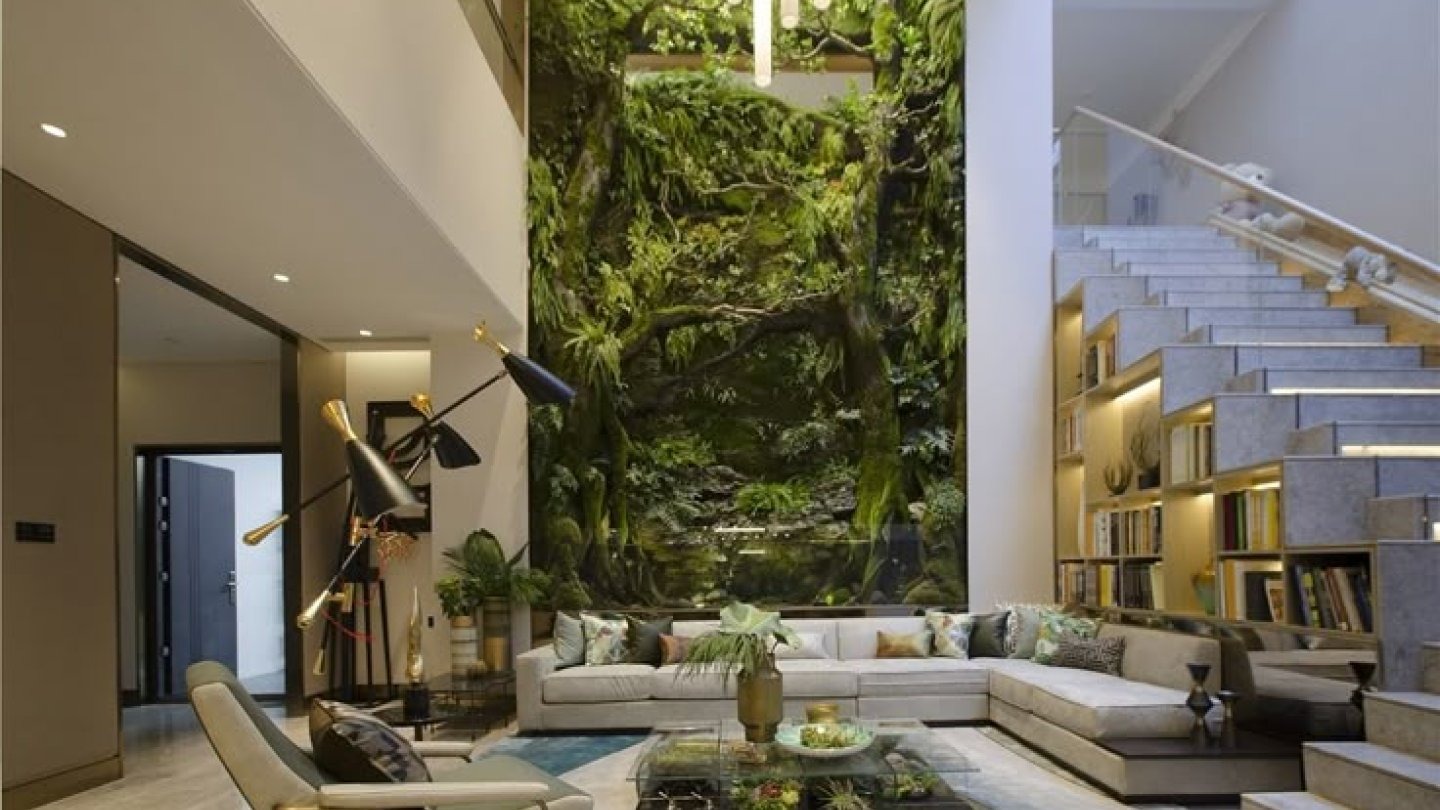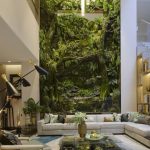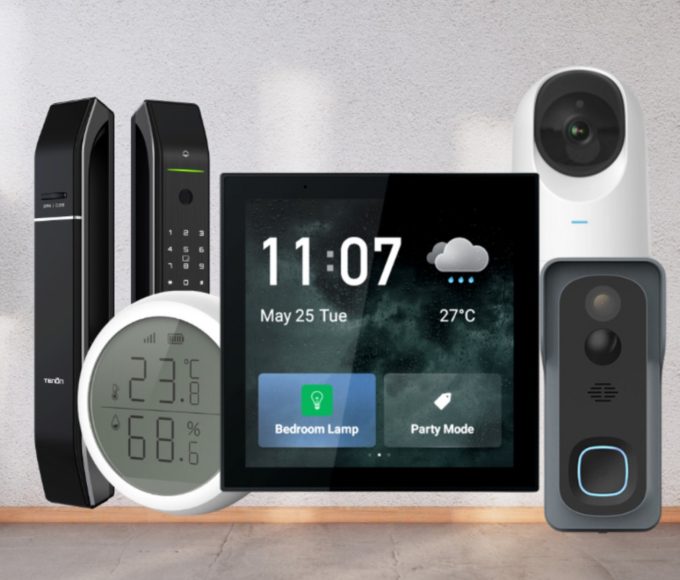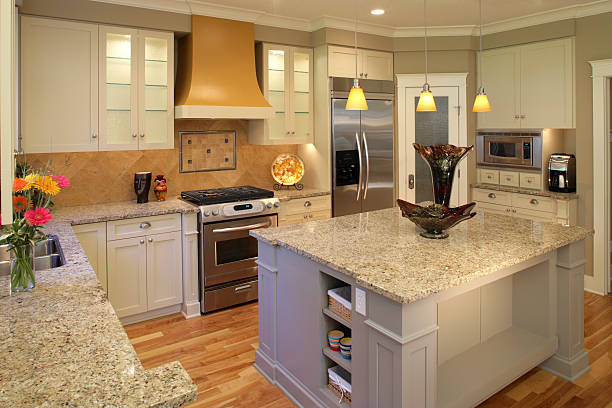In 2025, nature-forward interiors are more than a trend; they are a wellness choice. Moreover, homeowners are choosing spaces that help them sleep better and think clearly. When daylight and natural textures surround you, your stress responses ease. In fact, your body takes wood, stone, plants, and water as safety cues.
This blog demystifies the movement, explains why it matters, and shows you how to start. You will also find pro-level tips for tech-enabled homes. Above all, we’ll anchor each idea in practical steps tied to biophilic design trends 2025. Additionally, you will see affordable ideas that renters can adopt without renovations.
What Is Biophilic Design and Why It Matters
Biophilic design means designing with nature in mind. It blends sunlight, airflow, greenery, and organic materials into everyday rooms. Moreover, it uses shape, texture, and rhythm to echo the outdoors. Think of curved edges, matte finishes, and light that shifts gently through the day. Consequently, your nervous system relaxes because the environment feels familiar. Biophilic design trends 2025 expand the basics with circadian lighting, recycled materials, and hybrid indoor–outdoor spaces.
Soft greens, clay neutrals, and ocean blues will be used as stabilizing backdrops. In addition, tactile textiles like linen and wool replace slick synthetics. Small water features and soundscapes return as subtle anchors. Likewise, planters move from decor to micro-habitats that cluster plants by light needs.
Why does it matter right now? Homes do double duty as work, rest, and recovery zones. Furthermore, spaces with supportive light and texture reduce fatigue and visual stress. Plants, wood, and stone introduce mild, positive stimulation. As a result, attention lasts longer and moods stabilize during busy days. Thermal comfort and quiet airflow also improve daily comfort. In short, biophilia makes rooms humane, not just stylish.
Why Biophilic Design Is Booming in 2025
Three forces drive the surge. First, wellness moved home. People want rooms that restore their energy. Moreover, practicality now outranks seasonal decoration. Designers emphasize durability, repairability, and low-toxicity finishes. Consequently, materials like cork, bamboo, and limewash earn new respect.
Second, sustainability matured from buzzword to baseline. Homeowners ask about provenance, certifications, and VOC levels. Additionally, they prefer pieces that age gracefully instead of fast furniture. Reclaimed woods and recycled aggregates deliver texture with a story. Likewise, energy-efficient lighting now mimics the sun’s color arc.
Third, city living changed. Tiny balconies and pocket patios act as daily retreats. Meanwhile, sliding doors, screens, and planters blur boundaries. Work-from-home setups need clear air, soft daylight, and acoustic calm. Therefore, operable windows, vents, and linen drapery function as performance tools. The result is straightforward: demand for nature-connected spaces is surging. Ultimately, biophilia meets that demand with beauty and science.
Your 7-Point Kickoff
- Map sun paths and move key seating.
- Swap heavy drapes for sheers or layered shades.
- Group plants by light and water needs.
- Add one tactile hero per room for touch.
- Use a mirror panel to double daylight.
- Introduce a small water or sound element.
- Commit to low-VOC finishes on your next refresh.
Core Elements of Biophilic Design
Daylight keeps your circadian rhythm in balance—place seating where sun paths cross. Moreover, use translucent shades to cut glare without blocking light.
Natural Light & Airflow
Light shelves and mirrored panels bounce brightness deeper. Additionally, operable windows enable cross-ventilation on mild days. Trickle vents or quiet fans provide steady airflow. Consequently, rooms feel lively without constant HVAC.
Living Greenery & Indoor Gardens
Plants reduce visual hardness and add motion. Start with light-tolerant species matched to your windows. Cluster plants to create small habitats with shared humidity. Vertical gardens save floor space in compact rooms. Likewise, moss panels add texture without heavy maintenance. Kitchen herb rails bring scent and flavor into daily routines, making even small corners feel alive.
Organic Materials & Textures
Nature-coded materials invite touch and rest. Use oak, ash, or bamboo for floors and tables. Moreover, clay plaster regulates humidity and softens light. Linen, cotton, and wool breathe and patinate well. Additionally, tumbled stone offers forgiving edges and visual calm. Favor finishes that wear in, not out. Consequently, patina becomes memory rather than damage.
Water & Sensory Elements
Water hushes noise and steadies attention. Consider a tabletop fountain or narrow wall runnel. Furthermore, subtle nature soundtracks reduce cognitive load—layer scent with cedar, citrus, or herb bundles. Likewise, tactile ceramics and knotted wool rugs slow the eye. Engage sight, sound, touch, and smell with restraint. Therefore, the room feels rich without clutter.
Everyday Biophilia (Renters + Owners)
| Goal | Quick Win | Cost Range | Care Time | Why It Works |
| More daylight | Sheer curtains + mirror panel | $30–$120 | Low | Softens glare and bounces light deeper |
| Calm acoustics | Wool rug + linen drapes | $150–$400 | Low | Dampens echo and reduces mental fatigue |
| Greener vibe | Three easy plants in a cluster | $25–$90 | Medium | Shared humidity and fuller visual impact |
| Better air | Low-VOC cleaner + window routine | $10–$30 | Low | Cuts irritants and refreshes airflow daily |
| Gentle focus | Tabletop fountain near work zone | $40–$150 | Low | Masks noise and promotes steady attention |
Moreover, you can mix two quick wins for faster results. Additionally, renters can remove every upgrade without damage.
Top Biophilic Design Trends 2025 You’ll See Everywhere
- Sustainable Luxury Materials
“Eco-luxury” no longer feels rustic or austere. Expect reclaimed woods, recycled stone terrazzo, and linoleum made from natural ingredients. Moreover, plant-based oils and waxes replace plasticized finishes. Low-VOC paints keep indoor air cleaner for families and pets. Additionally, cork flooring delivers cushion, warmth, and easy repairs. These choices look refined and feel honest. Consequently, rooms read grounded rather than glossy.
- Smart Green Tech Integration
Tech should serve nature, not dominate it. Circadian lighting warms at night and cools by morning. Furthermore, sensors can dim lights when daylight peaks. Quiet purifiers complement plant clusters without replacing them. Additionally, smart vents balance airflow by room activity. Align routines with sun cycles where possible. As a result, your day feels less forced and more rhythmic.
- Hybrid Outdoor–Indoor Spaces
Homes extend into thresholds and patios. Use decking that echoes indoor tones for continuity. Moreover, outdoor rugs and weather-resistant linen make patios lounge-ready. Planters frame views and create privacy on small balconies. Likewise, folding tables host herbs, tea, or laptop breaks. Treat thresholds as rooms in their own right. Therefore, your usable space expands without a renovation.
- Emotional Color Palettes
Color carries mood signals from nature. Lean on forest greens, clay neutrals, river blues, and mineral grays. Additionally, soft whites stretch daylight into deeper rooms. Matte finishes prevent glare and visual fatigue. Moreover, pairing color with texture adds depth without noise. Keep accents leaf-bright, stone-muted, or bark-warm. Consequently, palettes feel immersive and steady.
Biophilic Design for Small Homes and Apartments
Small spaces thrive with clarity and repetition. Choose two materials and carry them through. Moreover, use closed storage to limit visual clutter. Replace one bulky bookcase with a vertical plant shelf. Additionally, a narrow console with rounded corners saves circulation space. Mirrors bounce daylight and extend sightlines. Likewise, leggy furniture shows more floor and air for perceived space.
Material tone matters when rooms are tight. Pale woods, clay tones, and warm grays lighten the mood. Furthermore, linen curtains soften both light and sound. A compact fountain hushes noise without stealing space. In addition, one oversized plant becomes a sculptural anchor. Limit patterns and celebrate texture. Consequently, the room breathes and so do you.
Small-space tips:
- Use one cohesive palette across rooms for calm continuity.
- Repeat one natural texture three times to stitch spaces.
- Choose multi-use furniture with rounded, touchable edges.
- Group plants by light level for easier care and fuller effect.
- Open windows daily for airflow, even in winter.
Biophilic Office and Work-from-Home Inspirations
Work zones need visual softness and stable light. If possible, place your desk near a window. Moreover, angle the monitor to avoid glare bands. Use a task lamp that warms toward evening. Additionally, keep a small plant within peripheral view. That mild motion reduces micro-stress during focus, resulting in longer sessions without strain.
Choose tactile, ergonomic pieces. A wood desk with a chamfered edge eases wrists. Furthermore, a breathable wool or mesh chair improves comfort. A cork pinboard organizes ideas quietly. In addition, a stone tray corrals cables and anchors the surface. Keep colors muted and earthy for sustained attention. Therefore, you work with the space, not against it.
Sound matters for deep work. Layer a rug over wood floors and add linen drapery. Moreover, a tiny water feature can mask traffic noise. Nature soundtracks also support flow state. Additionally, open windows between meetings for fresh air resets. Keep the tech understated and aligned with daylight. As a result, productivity feels humane, not forced.
How to Incorporate Biophilic Design Trends 2025 in Your Own Home
Start with light. Map how the sun moves through your rooms. Moreover, move seating to meet morning or late-afternoon light. Choose sheers for privacy while transmitting brightness. Additionally, add a mirror panel opposite the window to reflect light. That single step often changes the room’s energy. Consequently, mornings feel crisp and evenings feel calm.
Favor wood, stone, clay, and natural fibers. Furthermore, choose low-VOC finishes for clearer indoor air. Add one tactile hero per room, like a wool rug or linen headboard. Keep metals matte to avoid visual glare. Your hand should want to touch every surface. Therefore, the home invites slower, steadier rhythms.
Pick species matched to your actual light—moreover, group plants for shared humidity and fuller presence. Introduce a low-profile fountain where you work or read. Additionally, try a countertop herb garden for scent and use. Keep care routines small and repeatable. As a result, greenery thrives without becoming a chore.
Finally, connect rooms through color and scent. Let a nature palette repeat softly from space to space. Furthermore, diffuse cedar or citrus for a grounded, clean note. Display stones, branches, or shells as quiet artifacts. In addition, limit knick-knacks to maintain visual rest. Aim for harmony over spectacle. Ultimately, your expression of biophilic design trends 2025 will feel personal, not generic.
Action plan (weekend-ready):
- Rearrange seating to catch the best daylight first.
- Swap heavy drapes for sheers in one room.
- Add three matched planters; group near a window.
- Place a mirror panel to double the perceived light.
- Roll out a wool rug to calm acoustics.
- Set a simple plant-care timer on your phone.
Hidden Costs and Smart Savings
Budgets can derail good intentions unless you plan. Prioritize high-impact upgrades and delay the rest. Moreover, invest first in air quality and light control. Choose low-VOC paint when a wall already needs work. Additionally, source reclaimed wood for shelves or benches. Thrift stores often carry wool rugs and linen drapes at steep discounts. Consequently, you can build texture without overspending.
Avoid false economy. Ultra-cheap synthetics off-gas and fail early. Furthermore, flimsy finishes age poorly and require replacements. Spend where touch is constant, like handles and table edges. In addition, buy fewer pieces with honest materials and better hardware. Your rooms will age gracefully and feel substantial. Therefore, long-term cost drops even as comfort rises.
Common Mistakes to Avoid
People often add many small items and call it done, making the room feel busy. Moreover, scattered plants lack the power of grouped habitats. Others overlight spaces with cool-white bulbs. Additionally, glare and harsh contrast increase fatigue. Some choose too many finishes at once. Consequently, texture noise replaces calm.
Avoid these traps:
- Don’t place shade-loving plants in direct sun.
- Don’t combine glossy metals with high-lacquer woods.
- Don’t ignore airflow; even five minutes of fresh air helps.
- Don’t chase trends without a base palette.
- Don’t skip maintenance; tiny routines keep biophilia alive.
Case-Style Scenarios
Studio Balcony Refresh (One Afternoon)
Add sheers, a folding table, and two planters with herbs. Set a timer for watering twice weekly. On cool nights, bring a wool throw outside. Consequently, the balcony becomes a micro-retreat.
Rental Living Room Calm (Weekend Project)
Paint one wall with low-VOC clay beige. Additionally, place a mirror opposite the window for depth—group three plants on a slim bench. Likewise, lay a small wool rug to soften the echo. Add a tabletop fountain near the sofa. As a result, the room reads larger, warmer, and quieter.
WFH Productivity Nook (Budget Under $250)
Swap the chair cushion for breathable wool. Add a task lamp with warm evening settings. Mount a corkboard for clean organization. Keep a snake plant at the periphery of vision. Open the window between calls. Therefore, focus extends without fatigue.
Challenges and Misconceptions About Biophilic Design
Myth one: “Biophilia equals lots of plants.” The truth is wider and richer. Moreover, form, light, and texture carry equal weight. You can follow biophilic design trends 2025 with a few plants if the materials and light are right. Additionally, honest finishes and daylight do heavy lifting.
Myth two: “It’s expensive.” Luxury options exist, yes, but so do smart swaps. Furthermore, reclaimed wood and vintage ceramics offer character cheaply. Limewash and clay paints are DIY-friendly. In addition, phased upgrades let budgets breathe. Maintenance matters less when materials are durable. Consequently, you avoid constant patching and replacing.
Myth three: “It only fits rustic decor.” Modern, classic, and minimalist rooms all benefit. Moreover, matte finishes and soft edges play well with clean lines. Tech can quietly serve light and airflow. Additionally, balanced palettes keep spaces cohesive. Start small and learn as you go. Therefore, your design adapts as your life changes.
Frequently Asked “How Do I…?” Tips
- Keep plants alive: Match species to your actual light, not wishful thinking.
- Balance moisture: Use trays and stones to raise localized humidity.
- Tame glare: Choose matte surfaces and position lights across the room.
- Layer scent: Use natural oils sparingly; let fresh air lead.
- Clean gently: Favor plant-based cleaners to protect porous materials.
Moreover, review your setup monthly and tweak one element at a time. Additionally, write a short care checklist and keep it visible.
How to Create Calmer, Healthier Homes
Biophilic design makes homes calmer, kinder, and easier to live in. Light, airflow, natural materials, water, and plants work together. Moreover, you can scale upgrades from renter-friendly tweaks to full renovations. Start with daylight, then add texture and gentle motion. Additionally, rely on simple routines that keep materials and plants thriving. Your rooms will look better, yes, but they will also feel better every day. Finally, you now have the insights and steps to apply biophilic design trends 2025 with confidence. Begin with one room, trust your senses, and let nature guide the details.















Leave a comment